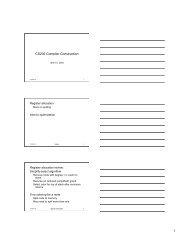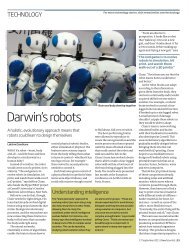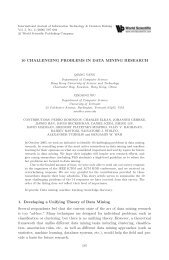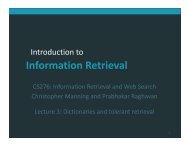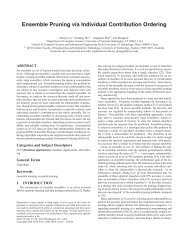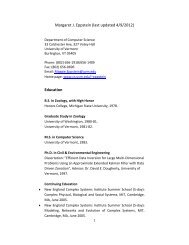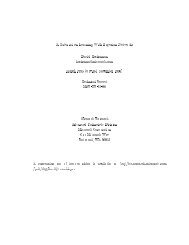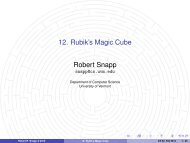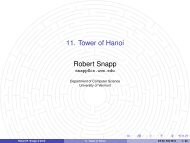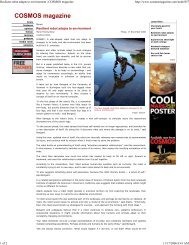Interactive Simulated Robot Construction and Controller Evolution
Interactive Simulated Robot Construction and Controller Evolution
Interactive Simulated Robot Construction and Controller Evolution
Create successful ePaper yourself
Turn your PDF publications into a flip-book with our unique Google optimized e-Paper software.
<strong>Interactive</strong> <strong>Simulated</strong> <strong>Robot</strong> <strong>Construction</strong> <strong>and</strong> <strong>Controller</strong><strong>Evolution</strong>[Extended Abstract]Paul BeliveauUniversity of VermontBurlington, VT 05405paul.beliveau@uvm.eduGreg HornbyJosh BongardUniversity of California University of VermontSan Diego, CA 92093Burlington, VT 05405gregory.s.hornby@nasa.gov josh.bongard@uvm.eduABSTRACTA robot’s morphology affects not only its capabilities, butalso its evolvability. Here we introduce an evolutionaryrobotics platform that will enable us to investigate the abilityof non-roboticists to collectively explore the design spaceof evolvable robot body plans. Users create robots in a simulatorusing an interactive interface, then let evolution finda controller that enables efficient locomotion. The user canchange the morphology of the robot <strong>and</strong> test the new designiteratively, altering the design based on the assessmentof the robot’s performance after a period of evolution ofthe controller. We investigate whether there is a correlationbetween the methods users choose to build robots <strong>and</strong> theevolvability of the robots.Categories <strong>and</strong> Subject DescriptorsI.2.9 [Computing Methodologies]: Artificial Intelligence—<strong>Robot</strong>icsGeneral TermsDesign, ExperimentationKeywords<strong>Evolution</strong>ary robotics, User-guided, Crowd-sourcing1. INTRODUCTIONIt is not clear what aspects of a robot’s morphology makeit evolvable. Biological organisms exhibit a wide variety ofsuccessfully evolved morphologies that we observe to buildgeneral intuitions about the relationship between morphology<strong>and</strong> behavior. Here we introduce an evolutionary roboticsplatform that will enable us to assess the ability of membersof the general public to collectively explore the spaceof evolvable robot body plans.User-controlled simulations such as breve [3] <strong>and</strong> framsticks [4]are available to the general public. The Foldit [1] onlinePermission to make digital or hard copies of all or part of this work forpersonal or classroom use is granted without fee provided that copies arenot made or distributed for profit or commercial advantage <strong>and</strong> that copiesbear this notice <strong>and</strong> the full citation on the first page. To copy otherwise, torepublish, to post on servers or to redistribute to lists, requires prior specificpermission <strong>and</strong>/or a fee.GECCO 2012 Philadelphia, PA USACopyright 20XX ACM X-XXXXX-XX-X/XX/XX ...$10.00.game has been successful in allowing non-expert users tocontribute to the prediction of possible protein configurations.Our goal is to use related methods to investigateevolvability.2. METHODSThe design environment uses the Open Dynamics Engine(ODE) physics engine with a graphics window <strong>and</strong>keyboard-driven input to allow users to build a robot froman initial set of disconnected blocks, cylinders, <strong>and</strong> hingejoints. The environment includes a light source as a target,<strong>and</strong> the blocks <strong>and</strong> cylinders incorporate light sensors thatthe evolutionary algorithm can use to measure fitness.We ran three trials of the experiment, using undergraduatestudents in the Computer Science department at theUniversity of Vermont.In the first two trials, the subjects were students whowere enrolled in an evolutionary robotics class. The studentshad used ODE for their class work <strong>and</strong> were familiar withrobotics in simulation. These early trials exposed shortcomingsin the user interface; no results from them are presentedhere.In the third trial, the subjects were students who wereenrolled in a Human-Computer Interface class. With two exceptions,these students had no formal instruction in robotics.The exceptions were students who had previously taken theevolutionary robotics class.The trial consisted of two 50-minute sessions: first, a selfguidedtutorial on how to use the simulator interface, thena session in which the subjects were asked to create a robotthat had the best potential for evolving efficient locomotion.Two restrictions were imposed: the robot had to be“legged”,<strong>and</strong> the size of the robot was limited to disallow a huge robot“falling over” in order to get close to the target.Users were free to watch their robot moving <strong>and</strong> to changeits morphology as often as they liked during the allottedtime. The simulator captured the time-stamped comm<strong>and</strong>keystrokes from each user’s session as well as the simulationenvironment that contained each user’s robot.3. RESULTSAbout half of the students (nine total) produced a robotthat could be simulated, though not all could be analyzedas intended (see below).We re-created the student robots, st<strong>and</strong>ardized the startingdistance for each robot from the target in the environment,<strong>and</strong> let the robots evolve for 24 hours (wall clock
Figure 1: <strong>Robot</strong> fitness for nine sample robots. Errorbars show the st<strong>and</strong>ard deviation in fitness forthe thirty runs.time). For this preliminary trial, we performed thirty independentruns of each student’s robot, using the ALPSalgorithm [2] . We took the best robot from each run <strong>and</strong> calculatedthe mean from the thirty runs to produce an averagefitness value for each robot.The bar graph in Figure 1 shows the average fitness forthe robots in this preliminary run, where fitness is definedas the distance from robot to target (smaller is better) atthe end of the simulation time. Of the nine robots shown,the rightmost three were excluded from further analysis.The best-performing robot, robot 9, moves by rolling,which disqualifies it. (The student found a way to makeit roll using a hinge joint.) The other two unusable robotswere created with an earlier version of the application,whichdid not include keystroke capture. For this reason, we cannotanalyze the user inputs for these robots.We are thus left with six robots <strong>and</strong> the comm<strong>and</strong> sequencesthat document their construction. We cannot drawconclusions from such a small number of datapoints, butscatterplots showing fitness <strong>and</strong> statistics from comm<strong>and</strong>keystrokes are shown in Figure 2 to illustrate our intentionsfor future research. Statistics include the count of subjects’use of comm<strong>and</strong>s, <strong>and</strong> time metrics.4. DISCUSSIONThe first two trials using the simulation environment showedthat the simulator was not robust enough for computerliteratecollege students, much less for the general public.Subsequent simulator improvements helped, so that the thirdtrial produced some data, but too small a percentage of usersproduced a working robot.The plots of fitness versus user input statistics shown inFigure 2 represent a first step in analysis that could reveal acorrelation between fitness <strong>and</strong> user behavior. For example,the mean time between comm<strong>and</strong>s might be interpreted asan indicator of the level of interest of the subject.Planned future work includes improvements to the systeminterface, in order to lighten the burden on the user <strong>and</strong> withthe ultimate goal of making the system game-like enough toattract many more users <strong>and</strong> to see if subjects’ intuitionsabout evolvability can be validated.We hypothesize that users do not have to be robotics expertsto collectively explore the space of robots amenable tooptimization by an evolutionary algorithm; they may be ableFigure 2: Selected user inputs vs. robot fitness(lower distance from target is better).to use their intuition <strong>and</strong> practical knowledge of mechanicalsystems as well as visual feedback from the simulator toguide robot development.5. ACKNOWLEDGMENTSThis work was supported by National Science FoundationGrant PECASE-0953837 <strong>and</strong> DARPA M3 grant W911NF-1-11-0076. The authors would also like to thank the VermontAdvanced Computing Center.6. REFERENCES[1] S. Cooper. Predicting protein structures with amultiplayer online game. Nature, 466:756–760, 2010.[2] G. S. Hornby. Alps: the age-layered populationstructure for reducing the problem of prematureconvergence. Proceedings of the 8th annual conferenceon genetic <strong>and</strong> evolutionary computation, pages815–822, 2006.[3] J. Klein. Breve: a 3d environment for the simulation ofdecentralized systems <strong>and</strong> artificial life.www.spiderl<strong>and</strong>.org/breve.pdf, 2008.[4] M. Komosinski. Framsticks: Towards a simulation of anature-like world, creatures <strong>and</strong> evolution.www.framsticks.com/biblio.



